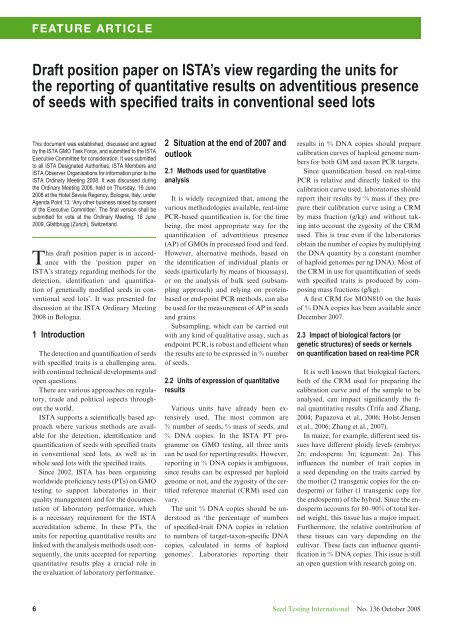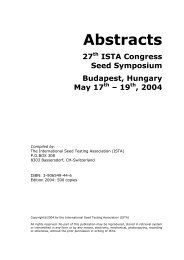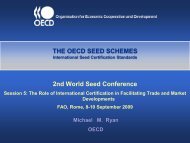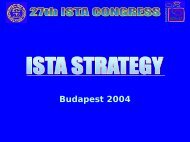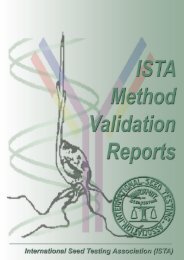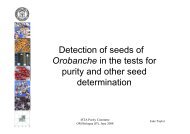(ISTA News Bulletin) No. 136, October 2008 - International Seed ...
(ISTA News Bulletin) No. 136, October 2008 - International Seed ...
(ISTA News Bulletin) No. 136, October 2008 - International Seed ...
Create successful ePaper yourself
Turn your PDF publications into a flip-book with our unique Google optimized e-Paper software.
Feature article<br />
Draft position paper on <strong>ISTA</strong>’s view regarding the units for<br />
the reporting of quantitative results on adventitious presence<br />
of seeds with specified traits in conventional seed lots<br />
This document was established, discussed and agreed<br />
by the <strong>ISTA</strong> GMO Task Force, and submitted to the <strong>ISTA</strong><br />
Executive Committee for consideration. It was submitted<br />
to all <strong>ISTA</strong> Designated Authorities, <strong>ISTA</strong> Members and<br />
<strong>ISTA</strong> Observer Organisations for information prior to the<br />
<strong>ISTA</strong> Ordinary Meeting <strong>2008</strong>. It was discussed during<br />
the Ordinary Meeting <strong>2008</strong>, held on Thursday, 19 June<br />
<strong>2008</strong> at the Hotel Savoia Regency, Bologna, Italy, under<br />
Agenda Point 13: ‘Any other business raised by consent<br />
of the Executive Committee’. The final version shall be<br />
submitted for vote at the Ordinary Meeting, 18 June<br />
2009, Glattbrugg (Zurich), Switzerland.<br />
This draft position paper is in accordance<br />
with the ‘position paper on<br />
<strong>ISTA</strong>’s strategy regarding methods for the<br />
detection, identification and quantification<br />
of genetically modified seeds in conventional<br />
seed lots’. It was presented for<br />
discussion at the <strong>ISTA</strong> Ordinary Meeting<br />
<strong>2008</strong> in Bologna.<br />
1 Introduction<br />
The detection and quantification of seeds<br />
with specified traits is a challenging area,<br />
with continual technical developments and<br />
open questions.<br />
There are various approaches on regulatory,<br />
trade and political aspects throughout<br />
the world.<br />
<strong>ISTA</strong> supports a scientifically based approach<br />
where various methods are available<br />
for the detection, identification and<br />
quantification of seeds with specified traits<br />
in conventional seed lots, as well as in<br />
whole seed lots with the specified traits.<br />
Since 2002, <strong>ISTA</strong> has been organizing<br />
worldwide proficiency tests (PTs) on GMO<br />
testing to support laboratories in their<br />
quality management and for the documentation<br />
of laboratory performance, which<br />
is a necessary requirement for the <strong>ISTA</strong><br />
accreditation scheme. In these PTs, the<br />
units for reporting quantitative results are<br />
linked with the analysis methods used; consequently,<br />
the units accepted for reporting<br />
quantitative results play a crucial role in<br />
the evaluation of laboratory performance.<br />
2 Situation at the end of 2007 and<br />
outlook<br />
2.1 Methods used for quantitative<br />
analysis<br />
It is widely recognized that, among the<br />
various methodologies available, real-time<br />
PCR-based quantification is, for the time<br />
being, the most appropriate way for the<br />
quantification of adventitious presence<br />
(AP) of GMOs in processed food and feed.<br />
However, alternative methods, based on<br />
the identification of individual plants or<br />
seeds (particularly by means of bioassays),<br />
or on the analysis of bulk seed (subsampling<br />
approach) and relying on proteinbased<br />
or end-point PCR methods, can also<br />
be used for the measurement of AP in seeds<br />
and grains.<br />
Subsampling, which can be carried out<br />
with any kind of qualitative assay, such as<br />
endpoint PCR, is robust and efficient when<br />
the results are to be expressed in % number<br />
of seeds.<br />
2.2 Units of expression of quantitative<br />
results<br />
Various units have already been extensively<br />
used. The most common are<br />
% number of seeds, % mass of seeds, and<br />
% DNA copies. In the <strong>ISTA</strong> PT programme<br />
on GMO testing, all three units<br />
can be used for reporting results. However,<br />
reporting in % DNA copies is ambiguous,<br />
since results can be expressed per haploid<br />
genome or not, and the zygosity of the certified<br />
reference material (CRM) used can<br />
vary.<br />
The unit % DNA copies should be understood<br />
as ‘the percentage of numbers<br />
of specified-trait DNA copies in relation<br />
to numbers of target-taxon-specific DNA<br />
copies, calculated in terms of haploid<br />
genomes’. Laboratories reporting their<br />
results in % DNA copies should prepare<br />
calibration curves of haploid genome numbers<br />
for both GM and taxon PCR targets.<br />
Since quantification based on real-time<br />
PCR is relative and directly linked to the<br />
calibration curve used, laboratories should<br />
report their results by % mass if they prepare<br />
their calibration curve using a CRM<br />
by mass fraction (g/kg) and without taking<br />
into account the zygosity of the CRM<br />
used. This is true even if the laboratories<br />
obtain the number of copies by multiplying<br />
the DNA quantity by a constant (number<br />
of haploid genomes per ng DNA). Most of<br />
the CRM in use for quantification of seeds<br />
with specified traits is produced by composing<br />
mass fractions (g/kg).<br />
A first CRM for MON810 on the basis<br />
of % DNA copies has been available since<br />
December 2007.<br />
2.3 Impact of biological factors (or<br />
genetic structures) of seeds or kernels<br />
on quantification based on real-time PCR<br />
It is well known that biological factors,<br />
both of the CRM used for preparing the<br />
calibration curve and of the sample to be<br />
analysed, can impact significantly the final<br />
quantitative results (Trifa and Zhang,<br />
2004; Papazova et al., 2006; Holst-Jensen<br />
et al., 2006; Zhang et al., 2007).<br />
In maize, for example, different seed tissues<br />
have different ploidy levels (embryo:<br />
2n; endosperm: 3n; tegument: 2n). This<br />
influences the number of trait copies in<br />
a seed depending on the traits carried by<br />
the mother (2 transgenic copies for the endosperm)<br />
or father (1 transgenic copy for<br />
the endosperm) of the hybrid. Since the endosperm<br />
accounts for 80–90% of total kernel<br />
weight, this tissue has a major impact.<br />
Furthermore, the relative contribution of<br />
these tissues can vary depending on the<br />
cultivar. These facts can influence quantification<br />
in % DNA copies. This issue is still<br />
an open question with research going on.<br />
6<br />
<strong>Seed</strong> Testing <strong>International</strong> <strong>No</strong>. <strong>136</strong> <strong>October</strong> <strong>2008</strong>


